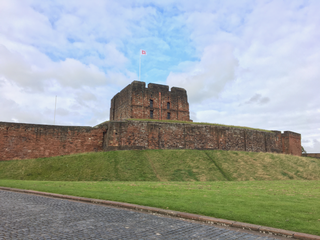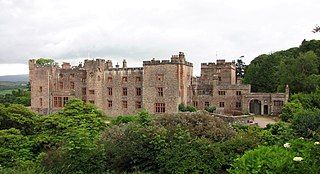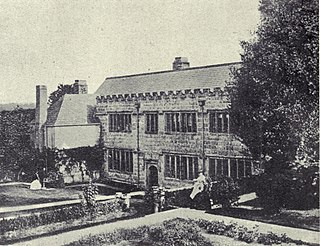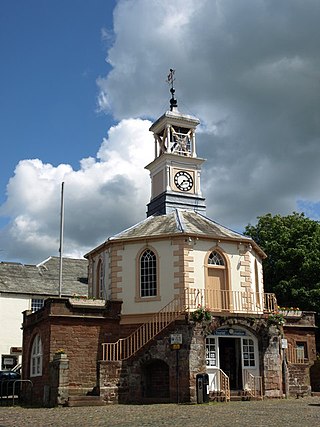
Millom Castle is an ancient building at Millom in Cumbria. It is a Grade I listed building and scheduled ancient monument. [1] [2]

Millom Castle is an ancient building at Millom in Cumbria. It is a Grade I listed building and scheduled ancient monument. [1] [2]
A manor on the site was granted to Godard de Boyvill, owner of the Manor of Millom, in around 1134. [3] The manor came into the Hudleston family's ownership in around 1240 when de Boyvill's granddaughter married into the Hudleston family. [4] John Hudleston was given a licence to crenellate in 1335. [3] The great tower dates from the 16th or perhaps 17th century. [5] [6] [7]
The Hudlestones took an active part in England's regional warfare. In the Wars of the Roses, Sir John Hudlestone fought on the Yorkist side, being present at the Battle of Blore Heath in 1459, and also the Battle of Bosworth Field in 1485. In 1460 Millom Castle was captured by Lancastrian forces. After the accession of Henry VII, Sir John and his son Henry secured a pardon and retained the estate. [8] In the English Civil War of the 1600s, Sir William Hudlestone was a leading Royalist colonel in Cumberland and Lancashire. He was defeated by Parliamentarian forces, and Millom Castle damaged by cannon fire in 1644. Heavy fines exacted by victorious Parliament began the slide of the Hudlestons into debt. [9]
By 1739 the castle walls were in dilapidated condition. [10] In 1748, Elizabeth Huddleston sold the castle to Sir James Lowther of Whitehaven. [11] The gatepiers were added in the 17th or 18th century. [12] [13] The great tower is now used as a farmhouse. [5]
A 3D explorable scan of the castle that includes parts of the castle off limits to the public due to safety restrictions has been produced. [14] The Millom & District Local History Society has written papers on the Castle and on an Archaeological Survey completed in 2024. [15]
The stone building has ashlar dressings and slate roofs. The east side has a gatehouse and 17th-century steps. The west side has a pointed entrance. Various barns and outhouses have been attached to the north and west sides. It has the remains of a moat to the north and west. [7]

Peel towers are small fortified keeps or tower houses, built along the English and Scottish borders in the Scottish Marches and North of England, mainly between the mid-14th century and about 1600. They were free-standing with defence being a prime consideration in their design, although "confirmation of status and prestige" also played a role. Additionally, they functioned as watch-towers, where garrisoned personnel could light signal fires to warn of approaching danger.

Millom is a town and civil parish on the north shore of the estuary of the River Duddon in southernmost Cumberland, Cumbria, England. It is situated just outside the Lake District National Park, about six miles north of Barrow-in-Furness and 26 mi (42 km) south of Whitehaven.

Carlisle Castle is a stone keep medieval fortress located in the city of Carlisle near the ruins of Hadrian's Wall. First built during the reign of William II in 1092 and rebuilt in stone under Henry I in 1122, the castle is over 930 years old and has been the scene of many episodes in British history.

Donnington Castle is a ruined medieval castle, situated in the small village of Donnington, just north of the town of Newbury in the English county of Berkshire. It was founded by Sir Richard Abberbury the Elder in 1386 and was bought by Thomas Chaucer before the castle was taken under royal control during the Tudor period. During the First English Civil War the castle was held by the royalist Sir John Boys and withstood an 18-month siege; after the garrison eventually surrendered, Parliament voted to demolish Donnington Castle in 1646. Only the gatehouse survives. The site is a scheduled monument under the care of English Heritage.

East Barsham Manor is an important work of Tudor architecture, a leading and early example of a prodigy house, originally built in the 1520s. It is located in the village of East Barsham, about 2.5 miles (4.1 km) north of the town of Fakenham and 2.1 miles (3.4 km) south west of the village of Walsingham in the English county of Norfolk. It is protected as a Grade I listed building.

Bickleigh Castle is a fortified manor house that stands on the banks of the River Exe at Bickleigh in Devon, England. Once considerably larger, Bickleigh now comprises a group of buildings from various periods which together formed a water castle.

Muncaster Castle is a privately owned castle overlooking the River Esk, about a mile east of the west-coastal town of Ravenglass in Cumbria, England. It is recorded in the National Heritage List for England as a designated Grade I listed building.

Waberthwaite is a small, former rural civil parish on the south bank of the estuary of the River Esk, in Copeland, Cumbria, England. Since 1934 it has been part of the combined parish of Waberthwaite and Corney, which covers 10 square miles and has a population of 246. It is located opposite Muncaster Castle and the village of Ravenglass which lie on the north bank of the Esk. It is well known for its Cumberland sausages, and lists among its other assets a granite quarry that is a Site of Special Scientific Interest (SSSI); the Esk estuary, which forms part of the Drigg Coast Special Area of Conservation (SAC) - a designation for areas of European importance; the 800-year-old St. John's Church, and the remains of two Anglian/Norse crosses of an earlier period. Archeological finds within 3 kilometres of Waberthwaite indicate that the area has been continuously inhabited since Mesolithic times.

Lullingstone Castle is a historic manor house, set in an estate in the village of Lullingstone and the civil parish of Eynsford in the English county of Kent. It has been inhabited by members of the Hart Dyke family for twenty generations including current owner Tom Hart Dyke.

Brougham Castle is a medieval building about 2 miles (3.2 km) south-east of Penrith, Cumbria, England. The castle was founded by Robert I de Vieuxpont in the early 13th century. The site, near the confluence of the rivers Eamont and Lowther, had been chosen by the Romans for a Roman fort called Brocavum. The castle, along with the fort, is a scheduled monument: "Brougham Roman fort and Brougham Castle".

Appleby Castle is in the town of Appleby-in-Westmorland overlooking the River Eden. It consists of a 12th-century castle keep which is known as Caesar's Tower, and a mansion house. These, together with their associated buildings, are set in a courtyard surrounded by curtain walls. Caesar's Tower and the mansion house are each recorded in the National Heritage List for England as a designated Grade I listed building. The uninhabited parts of the castle are a scheduled ancient monument.

Ravensworth Castle is a ruinous Grade II* listed building and a scheduled monument situated at Lamesley, Tyne and Wear, England. The building has been destroyed and rebuilt a number of times, and was the seat of the Ravensworth barons, the Liddells.

Rose Castle is a fortified house in the parish of Dalston, Cumbria, England. It was the residence of the bishops of Carlisle from 1230 to 2009, and has been a peace and reconciliation centre since it was sold by the Church Commissioners to the Rose Castle Foundation in 2016. The castle is a grade I listed building.

Burneside Hall is a converted medieval pele tower in Burneside, Cumbria, England.

Wharton Hall in Wharton, Cumbria, England, is a medieval fortified manor house.

Holy Trinity Church is a medieval building situated next to Millom Castle near the town of Millom, Cumbria, England. It is an active Anglican parish church in the deanery of Furness, the archdeaconry of Westmorland and Furness, and the diocese of Carlisle. Its benefice is united with those of St George, St Anne, Thwaites, and St Luke, Haverigg. The church is recorded in the National Heritage List for England as a designated Grade I listed building.
Millom is a civil parish in the Borough of Copeland, Cumbria, England. It contains twelve buildings that are recorded in the National Heritage List for England. Of these, two are listed at Grade I, the highest of the three grades, and the others are at Grade II, the lowest grade. The parish contains the town of Millom and the surrounding countryside. Until the middle of the 19th century the parish was mainly rural. The railway arrived in 1850, iron mining began in the 1860s, and the town grew rapidly. Only one listed building survives from the mining industry, a former office. The other listed buildings are two churches, one dating from the 13th century, the other from the 19th century, and structures in and around their churchyards, a former manor house with a great tower and associated gate piers, and three war memorials.

Carlisle Citadel or The Citadel is a group of buildings on the site of a former early modern fortress on English Street in Carlisle, Cumbria. It comprises two towers, both of which are Grade I listed buildings: the Nisi Prius Courthouse and the former Crown Court.

Penheale Manor is a Grade I listed manor house and historic building one mile north of Egloskerry, Cornwall.

The Moot Hall is a municipal building in The Market Place in Brampton, Cumbria, England. The building, which is used as a local tourist information office and as a meeting place for Brampton Parish Council, is a Grade II* listed building.